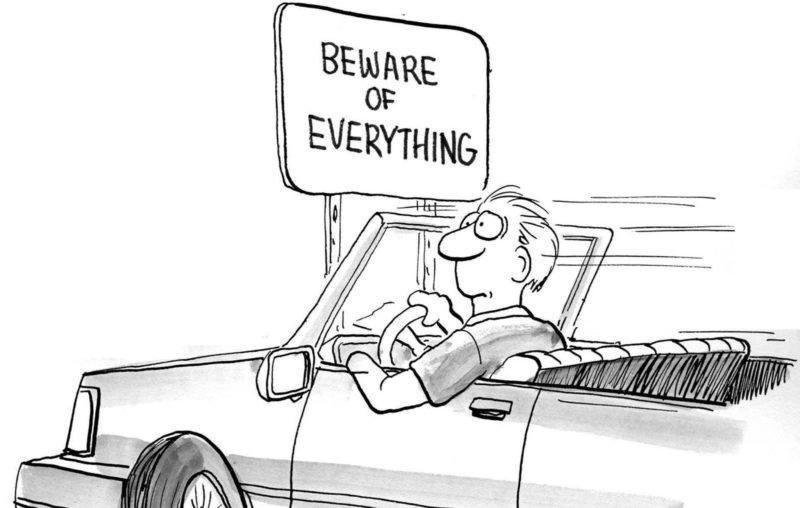Evolutionary Failure: When Mass Psychology is like a Negative Technology Shock

The 2020 recession resulting from the SARS-CoV-2 pandemic is not just another recession. Rising fear of coming together to exchange in markets limits how much we can benefit from the division of labor and the agglomeration economies that come with living in close proximity to other humans. There is no return to normal while we fear being close to one another. Limits to the division of labor have lasting consequences.
There are three major economic theories explaining the causes and consequences of recessions: real business cycle theories emphasize exogenous shocks to the allocation of capital in the economy, monetary theories emphasize the role of the money supply in the valuation of economic assets, and psychological theories of recessions emphasize the excessive exuberance of an economic boom followed by pessimism surrounding economic decline (Keynesianism).
On first glance, the current crisis may look like a recession triggered by an exogenous shock akin to a natural disaster. When the pandemic started, many of us hoaded flour, rice, and toilet paper and stopped going to restaurants. These responses are not much different than what you would do if a hurricane was headed your way. But this is more than an instantaneous capital shock.
There is something about this recession that makes it more significant than an exogenous shock. Before we return to normal, the economy has to adjust to a new fear of others as threats. This fear will last at least as long as our mindset is one of panic, and may be a more permanent change to our human interactions. Just like in previous recessions, supply chains have rebounded from the initial shock and stores again carry plenty of staples and paper products. But store inventory changes are an example of a short-run adjustment. Longer-run adjustments must confront the fundamental change in our use of the existing capital structure.
Higher education offers one concrete example of this change. Given our new pandemic outlook on the world and the required social distancing, many of the classrooms we teach in are too small to accommodate the number of students registered for fall classes. Our University is adjusting to this shortage of space by asking some students to stay in their dorm rooms each day and watch their professors lecture synchronously online. Each student will get a chance to be face-to-face at least 50% of the time they would ordinarily spend in the classroom.
What may be acceptable practice for the short-run, however, will unlikely be the norm for the future, if social distancing continues. Existing classroom layout will have to be rethought, classes will have to continue in this new hybrid style, or class sizes will have to be decreased. Each of these adjustments comes with its own costs: the cost of renovations to classrooms, changes in the sticker price of higher education in order to acknowledge the fact that only part of the education the students are paying for is delivered in-person, or a higher cost per student for lower student density in the classroom. These changes in the costs and benefits of higher education will ultimately increase the price of face-to-face education and the same is true for many other services we consume including air travel, swimming lessons, and childcare.
Most routine economic activities are being permanently altered to accommodate changed consumer preferences and a new regulatory environment, and these changes are costly.
The fact that indoor play areas, trampoline parks, restaurants, retail stores, movie theaters, hotels, corporate offices, and school rooms are now poorly designed for our new social distancing norms means that people are unwilling to return to these spaces without radical redesign (there is a lot more plexiglass in our world since March of 2020) or a significant reduction in the number of people in each space (just think of those roped off areas of retail and social spaces). This was the year that we all became germaphobes, and this might not change (see Jeffery Tucker’s piece). The permanence and severity of this change will ultimately determine how much readjustment has to happen in the allocation of capital and how much poorer we will all be as a result.
The cost of converting pre-virus capital structure into retail, social, and working spaces that accommodate how we now view relationships and social interactions are large. In a typical recession caused by the misallocation of capital resources, mistakes in investment are corrected and transformed into capital that better aligns with consumer preferences.
In this recession, we are seeing something like a permanent downward shift of the demand for every economic exchange involving social interactions: from our demand for restaurant visits, over office luncheons, to zoo trips. It was a far better world when we didn’t have to worry about transmitting or contracting a virus and everything we now do in this new virus-dominated world is in some sense less than what it used to be: fewer friends at your kid’s party, fewer meals at restaurants, fewer people at the zoo, no large gatherings. We don’t make the same choices now as we did then, and so much the worse for us economically.
Whatever the details may be of what this new world will look, our collective fears have already set in motion significant changes to its capital structure. Take as an example kid birthday parties: so many of the birthday parties that happen in this country depend on the use of air-conditioned space which can account for the cold of winter and the heat of summer. It is big business to have parents dropping kids off in a controlled space for an hour or two in exchange for only the cost of a plastic birthday present. That whole social ritual has changed permanently. The new hype in birthday parties are drive-by parties, and while those may be fun in the short run, you do not have to be 8 to understand they are not quite the same as the status quo before the virus.
Schooling is experiencing what may be among the most significant changes. The world in which temperatures are taken daily is one of unprecedented intrusion into privacy, but this increase in the amount of health-related information being collected on a daily basis will also reveal the extent to which we have ignored the spread of viruses and bacteria in the past. Getting sick in school never received the level of attention it will this year. Administrators might ask, “How can we go back?” Who says that taking temperatures of kids should stop? Better data about the flu, and experience with this virus, should prime us to shut schools down more nimbly every flu season.
The corporate world has changed as well. While we do not yet know the details of the adjustments that are being made, we know the resulting changes in the value of commercial (as well as residential) real estate will be massive.
We are in the midst of a great experiment testing the effects of a major shift towards remote work on commercial and residential real estate markets. Only those firms that experienced significant productivity losses as a result of the shutdown will want employees back in their cubicles. Those that did not will likely extend their work-from-home policies further into the future. This means the capital stock is again affected: corporate rents may fall, residential housing rents will change because of lower commuting cost, increased demand for square footage, and increased demand for social distance.
In the spring, demand for above-ground pools and playsets took off as parents were anticipating a summer with their kids at home and little access to public venues. If demand for these kinds of outdoor and garden toys is any indication of what may happen in the market for residential real estate, we expect demand for suburban homes with big yards to increase while demand for urban apartments and townhouses may dwindle.
Maybe the most significant change is the way retail space is used. As customers are hesitant to enter indoor commercial spaces, stores are changing the way they do business with some closing off their retail space completely and instead delivering to your car, while others maintain small shopping windows, or limit the number of customers they allow into their stores.
Some entrepreneurs were lucky enough to find ways to minimize losses, and others will fail. Some new entrants will come into the market. All of these changes occasion a dramatic shift in the way retail space will be arranged. Makeshift plexiglass dividers will become more permanent and customers will become increasingly more comfortable with placing orders for pickup, reducing the square footage needed for browsing.
These changes have been advertised as measures needed to contain the spread of the virus in the short run, but the long-run adjustments they trigger will reflect our changed subjective risk evaluation. This change in how we evaluate the risk of interacting with others likely has longer term effects that will not be eliminated as soon as a vaccine is available. In the global economy, the changes in the division of labor that started with Brexit and Trump’s grandstanding against China are exacerbated by the breakdown of trade we are voluntarily imposing on ourselves.
This general acceptance of a fear of others that separates us from each other exacerbates all our worst proclivities and maximizes the economic destruction of the pandemic. We need to return to a robust market to preserve the division of labor. Perhaps you think this is an exaggeration, and we hope you are right, but we also hope you will join us in asking for some moderation in the panic around the new virus.












